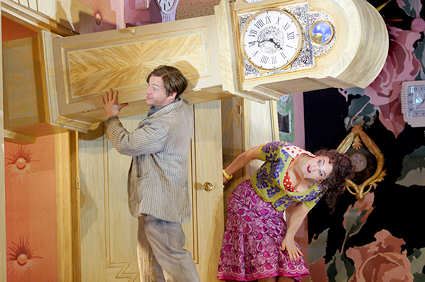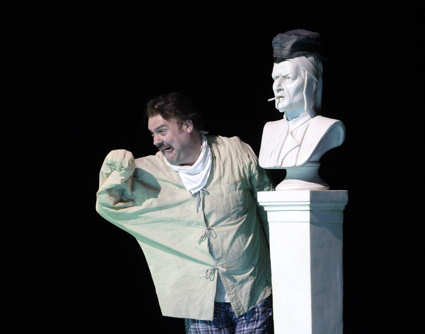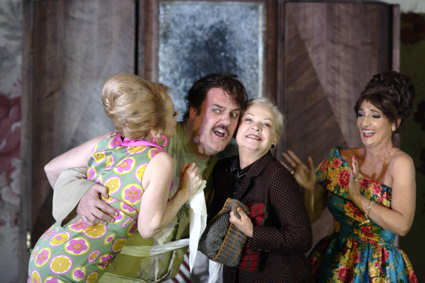Ravel, L’Heure espagnole
and
Puccini, Gianni Schicchi :
new productions by Richard Jones (director), John
Macfarlane (set designs), Nicky Gillibrand (costumes
designs), various soloists and orchestra of The
Royal Opera House, Antonio Pappano (conductor)
Covent Garden, London. 30. 3.2007
(JPr)

L’Heure Espagnole: Christine
Rice (Concepcion)
Christopher Maltman (Ramiro)
Forgive me for an immediate digression but I was
reminded through the first half of this
operatic double bill of those later Nureyev ballet
evenings. He never lost his star quality even
as his powers diminished, and he was put on in
showcases of often short ballets, appearing in
some and not others. The audience often waited
and waited for him to appear. Something of the
same happened at Covent Garden. Many in the audience
who had not prepared themselves for what they
were seeing wondered why he did not appear before
the interval and anxiously, no doubt, studied
their watches wondering where Bryn Terfel was
in the second half. Forty-five minutes from the
end of a short evening on stage he came on and
an already fun evening took off even more. There
is a danger that this review could take longer
to read than the operas to perform, so I had better
get on with it.
Ravel’s L'Heure espagnole (The Spanish
Hour)
is a one-act comic opera, based on the play of the
same name by Franc-Nohain which was first
performed at the Théâtre
de l'Odéon in 1904. The composer thought of his
work as a ‘conversation in music … with the
tradition of the Opera Bouffe’. The French farce
of a plot involves Concepcion, wife of Torquemada,
clockmaker of Toledo in the eighteenth century,
taking the advantage of his regular Thursday
absences to service the municipal clocks to allow
her to entertain her Latin lovers. On this
particular Thursday her plans are first thwarted,
and then transformed, by the presence of Ramiro, a
simple but muscular muleteer. The term ‘farce’
always makes me think of slamming doors and
dropping trousers. Here as her
several partners in adultery are on the verge of
colliding there is much of the former, including
imprisonment in large clocks, but fortunately none
of the latter. All are finally interrupted by the
return of Torquemada. Clocks have gone up and down
to the bedroom throughout the work and all is
resolved by the cuckolded husband allowing Ramiro
to set Concepcion’s alarm-bells ringing anytime he
comes by when he is out!
Ravel wrote the work mainly in 1907, hoping it
would be performed at the Opéra-Comique at the end
of 1908; however, Albert Carré, the theatre’s
director, rejected it as being too risqué for his
audience. Ravel persevered for several years and
it was only after an important intervention of
Mme Jeanne Cruppi,
singer and wife of a government minister, that the
opera finally its première on 19 May 1911. The
work carries the
dedication - ‘A Mme Jeanne Cruppi, hommage de
respectueuse amitié’.
Ravel insisted that the music must be funny in a
comic opera, cue demented mechanical ticking,
unconvincing cuckoos and other unusual orchestral
sounds including a contrabass sarrusophone.
I
don’t think Richard Jones quite had his heart in
this as much as in the following one-acter. He
cannot be blamed for not throwing everything at
it. The full stage machinery is used by designer
John Macfarlane to draw us into the comedy. During
that surprising dark beginning to the music the
set moves forward as we seem to zoom into this
fantasy world. We have been greeted by a
proscenium front drop painting of large breasts
held in a polka dot dress top and we enter the
world of the ‘Carry On’ films and seaside saucy
postcards. In fact the one misjudgement of the
whole evening was Christine Rice’s Concepcion. Her
voice is outstanding and she looks a ‘Yummy-Mummy’
to use this modern phrase but she never convinces
that she has the sexiness to attract so many men.
The rest was perfect casting, from Bonaventura
Bottone’s simple, deceived Torquemada, Yann
Beuron’s dozy, love-lorn poet, Gonzalve, Andrew
Shore’s typically spot-on characterisation of a
ruddy-cheeked lascivious banker, Don Inigo Gomez.
I struggled at first to recognise Christopher
Maltman with his floppy hair as the beefy innocent
Ramiro but for me he was a revelation, with
excellent comic timing and was perfectly cast.
There are precious few laughs at the start but it
picks up a bit as it goes on. However the joke
wears a little thin and Richard Jones has probably
realised this by the time get to the finale where
we have six statuesque Las Vegas showgirls to add
sparkle to the Habanera. Overall, undoubtedly all
good fun but also a near miss.

Bryn Terfel as
Gianni Schicchi
The première of Gianni Schicchi (as part of
Puccini’s triptych Il Trittico) took place
in New York on 14 December 1918 because most of
the singers back in Italy were in military
service, and naturally operatic life suffered
because of this. The composer very much wanted his
opera to be premièred ‘at home’ especially since
he could not travel to the US because it was
difficult to get a visa even had it been safe to
travel. In spite of Puccini’s absence, the
première of Il Trittico was a great
success, especially Gianni Schicchi.
In Buoso Donati's room his greedy relatives
surround him with prayers while he is dying. They
have heard rumours that he has left all he has to
some monks. After this proves to be true, the
peasant Gianni Schicchi is their only hope.
Lauretta, his daughter, is in love with Rinuccio,
Buoso's nephew. Lauretta makes her heartfelt plea
(yes, ‘that’ song!) to ask for her father's help.
Schicchi explains the way to alter Buoso's will.
Because no one outside the room apparently knows
of Buoso’s death, Schicchi dresses himself in
Buoso’s nightclothes, climbs into bed in a
darkened room and the notary and two others is
called to witness the changes to the testament.
‘Buoso’ now leaves only small items to the
relatives and the important possessions to Gianni
Schicchi. After the notary leaves, the relatives
riot and attack Schicchi, who survives. He has
reminded the family throughout how seriously the
authorities would view their activities if they
were to be found out. He suggests to the audience
that if they have enjoyed themselves, he may be
forgiven for his crime. Rinuccio and Lauretta stay
with him whilst everybody else leaves.
After a front drop painting of spaghetti and a
fork rises there is the one reservation that
followers of Richard Jones have seen some of what
is revealed before. John Macfarlane’s 1970’s sets,
wallpaper, ceiling lights, TV, wardrobe, bed and
all, and Nicky Gillibrand’s same-era costumes have
been seen particularly recently in their superb
Lady Macbeth of Mtsensk for Covent Garden.
Jeremy White (Betto di Signa) was definitely Jim
Royle. I am not familiar enough though with The
Royle Family programme to know how far this
influence extended elsewhere through the staging.
This sense of over-familiarity is quickly
forgotten by an exuberant ensemble performance
with too many marvellous individual contributions
to name everyone. Perhaps the veteran Gwynne
Howell’s hangdog Simone and the Italian, Elena
Zilio making her Royal Opera début as Zita
(made-up as one of Julie Walters’ elderly
creatures) deserve particular mention.Marvellous
and often small inventive detail delighted as the
relatives tear the place apart to search for the
will, they hang down from the loft in the ceiling
and come up through the floor, the hidden body
under the floor kicks up a floorboard threatening
discovery and in the will-reading without words
(moments of genius in music by the composer) the
tension is palpable until the last page when all
realise only the monastery’s benefits and are
distraught.

Joan Rodgers (Nella)
Bryn Terfel (Gianni Schicchi)
Elena Zilio (Zita) and Marie McLaughlin (La
Ciesca)
The young Albanian Samir Pirgu as Rinuccio seems
another tenor discovery with great potential and
he sang a full-bloodied ‘Firenze
è come un albero fiorito’ but only just hang on at
the end and must take care and not do too much too
soon.
Finally on comes Bryn Terfel, a man-mountain of a
janitor/handyman, with flat cap, fag in mouth,
jeans and just about sparing us the ‘builder’s
bum’. Even surrounded as he was by wonderful
character actor-singers, Terfel can act more than
all the others together with just a hand – all
that was visible from behind a door during Dina
Kuznetzova’s slightly underwhelming ‘O mio babbino
caro’ – and his eyes when otherwise covered up as
Buoso in the deathbed. Perhaps it is me but I get
the idea that Terfel relishes these comic roles so
much more that the Wotans he possibly feels forced
into.
We last see Terfel embracing a bust of Dante at
the front of the stage, putting his cap on its
head and a cigarette in the mouth. Gianni
Schicchi had its inspiration from a few lines
of no obvious comic potential from Dante’s
Inferno. I suppose this could be seen as a
reflection of a subversive tribute to one Italian
cultural icon from another.
Almost forgotten in all this is Antonio Pappano’s
conducting of his always consistent Royal Opera
House orchestra. He revelled throughout the
evening in both scores underlining the jollity and
cartoon-like action on stage with much gusto.
When
these two comedies were last put on at Covent
Garden in 1961-62 they were part of a triple bill
with Schoenberg's Erwartung. The ticket
prices (up to £170) are higher now and so is the
drawing power on stage (Terfel): but is it worth
excluding so many who cannot afford these
exorbitant prices from experiencing the joy of
these two typical Richard Jones productions and
possibly being hooked on opera for the rest of
their lives?
Jim Pritchard
Pictures
© Catherine Ashmore
Back
to the Top
Back to the Index Page

